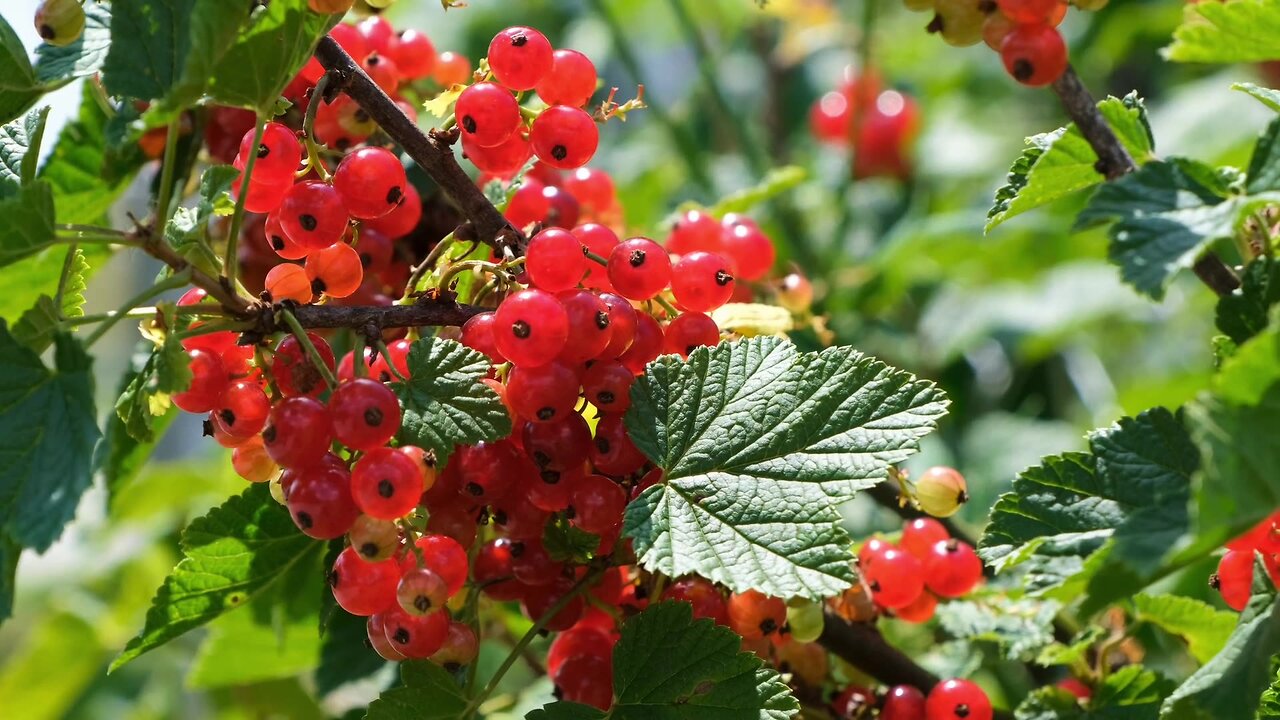Premium Only Content

"Exploring the Redcurrant: A Tart Treasure"
Redcurrants (*Ribes rubrum*) are small, glossy, red berries that grow on shrubs belonging to the gooseberry family. They are native to parts of Europe and are widely cultivated for their vibrant color, tangy flavor, and nutritional benefits.
### Appearance and Growth
- **Berries**: Redcurrants are small, round, and typically bright red, although there are also white and pink varieties. The berries grow in clusters and have a translucent, jewel-like appearance.
- **Shrubs**: The redcurrant shrub is a deciduous plant that grows to about 1.5 meters (5 feet) tall. It has lobed leaves and produces clusters of berries in mid to late summer.
### Culinary Uses
- **Fresh Consumption**: Redcurrants can be eaten fresh, but their tartness often makes them better suited for culinary applications.
- **Cooking and Baking**: They are commonly used in jams, jellies, syrups, and sauces. Redcurrants also add a tangy flavor to desserts, such as pies and tarts, and can be used as a garnish.
- **Beverages**: Redcurrants are also used to make liqueurs, wines, and fruit cordials.
### Nutritional Benefits
- **Vitamins**: Redcurrants are rich in vitamin C, which supports immune function, skin health, and overall vitality.
- **Antioxidants**: These berries contain high levels of antioxidants, including flavonoids, which help protect the body against oxidative stress and inflammation.
- **Fiber**: Redcurrants provide dietary fiber, aiding digestion and promoting a healthy gut.
### Cultivation
- **Climate**: Redcurrants thrive in temperate climates and prefer well-drained, slightly acidic soil. They are often grown in gardens or on farms.
- **Care**: The shrubs are relatively low-maintenance, requiring pruning to maintain shape and encourage fruit production. They are also frost-hardy, making them suitable for cooler climates.
### Historical and Cultural Significance
- **Traditional Uses**: In some cultures, redcurrants have been used for centuries in folk medicine for their supposed health benefits. They were also historically valued as a food source and for making dyes.
- **Symbolism**: In some European countries, redcurrants are associated with vitality and life, thanks to their bright color and abundant growth.
Redcurrants are versatile and beneficial, making them a popular choice in both gardens and kitchens. Their unique flavor profile, combined with their health benefits, ensures they remain a cherished fruit across many cultures.
-
 2:21:20
2:21:20
Robert Gouveia
13 hours agoTrump Goes to SCOTUS! Judge CAVES on DOGE? Fani Willis Not Happy!
127K32 -
 20:41
20:41
Stephen Gardner
13 hours ago🔥You Won't BELIEVE What JUST Happened To Don Trump Jr.!!
134K215 -
 58:00
58:00
The StoneZONE with Roger Stone
11 hours agoEuropean Leaders Resist Trump Peace Overtures To Their Own Demise | The StoneZONE w/ Roger Stone
95.8K12 -
 9:29
9:29
AlaskanBallistics
13 hours ago $12.11 earnedWyoming Suppressors and Rifles at Shot Show 2025
113K6 -
 1:06:40
1:06:40
Donald Trump Jr.
17 hours agoThe Left is Taking one L After Another, Live with Michael Knowles | Triggered Ep. 217
201K152 -
 47:17
47:17
Kimberly Guilfoyle
17 hours agoWoke Gets DOGE’d, Live with AJ Rice & Jarrett Stepman | Ep. 197
145K45 -
 20:11
20:11
Candace Show Podcast
15 hours agoBecoming Brigitte: Candace Owens x Xavier Poussard | Ep 6
218K375 -
 8:25:38
8:25:38
Dr Disrespect
20 hours ago🔴LIVE - DR DISRESPECT - ELDEN RING DLC - REVENGE
207K22 -
 54:22
54:22
LFA TV
1 day agoThe End of the Trans-Atlantic Alliance | TRUMPET DAILY 2.17.25 7PM
58.7K11 -
 55:56
55:56
BIG NEM
18 hours agoUGLY COCO: The Rapper Who’s Tried EVERY PSYCHEDELIC 🌌
29K2